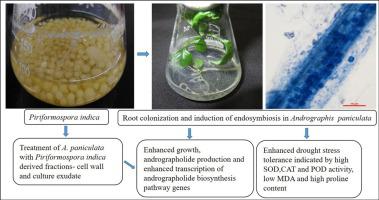Industrial Crops and Products ( IF 5.9 ) Pub Date : 2020-08-14 , DOI: 10.1016/j.indcrop.2020.112835 Deepthi Suseelan Nair , Sakuntala Manjula

|
Andrographis paniculata [(Burm. f.) Wall. ex Nees, family Acanthaceae], is an important medicinal plant used in Indian and Chinese traditional systems of medicines. The therapeutic activity of A. paniculata is due to the presence of andrographolide, a diterpenoid lactone with potent pharmacological activities. Andrographolide and its various semi synthetic derivatives are of high therapeutic potential and therefore of high demand. Due to the complex structure of andrographolide, chemical synthesis has not been effective till date and thus the pharmaceutical industry depends on A. paniculata for extraction of pure andrographolide. The content of andrographolide in A. paniculata is low (14.28 ± 1.62 mg/g DW) and thus biotechnological interventions are essential for enhanced production of andrographolide. The potential mutualistic role of endosymbiosis in enhancing the yield of andrographolide in in vitro cultures of A. paniculata was studied and the salient findings obtained are reported. It was consistently observed that colonization of roots of A. paniculata seedlings by the mutualistic endosymbiotic fungus Piriformospora indica resulted in significant enhancement of andrographolide (58.2 ± 6.5 mg/g DW) in comparison to control plants (19.5 ± 2.3 mg/g DW), along with a correlated increase in plant biomass. Fractions derived from P. indica such as cell wall and culture exudate were also employed to study their effect on andrographolide and biomass yield. It was observed that these fractions successfully improved the growth rate of the plant along with elevated andrographolide production, with maximum andrographolide content (55.8 ± 3.2 mg/g DW) observed in cell wall fraction treated seedlings. Under all the treatment conditions the transcriptional regulation of andrographolide biosynthetic pathway genes were analysed using RT-qPCR and correlated with andrographolide content. Andographolide biosynthesis pathway genes- GGPS, HMGS and DXR showed a significantly high transcript level expression and correlation with andrographolide accumulation over a period of 35 days in case of all the treatments studied. The potential protective role of P. indica colonization under host abiotic stress was demonstrated in A. paniculata seedlings exposed to abiotic stress conditions induced by poly ethylene glycol. Piriformospora indica colonized plants under drought stress exhibited normal morphology, high antioxidant enzyme content, low malondialdehyde accumulation and high proline content when compared with the control plants. The observations prove that P. indica and P. indica derived fractions can be used as an ideal bio stimulator to enhance the biomass (2.344 fold) and andrographolide content (3.91 fold) in A. paniculata. The findings also showed that as A. paniculata is significantly affected by drought stress, P. indica can also be used as a helpful eco-friendly tool to confer drought stress tolerance, thereby improving biomass and andrographolide yield. Moreover, the biostimulants present in the fungal cell wall fractions and culture exudates can be purified and characterized for exploring their further functional roles in order to develop products of commercial value.


































 京公网安备 11010802027423号
京公网安备 11010802027423号